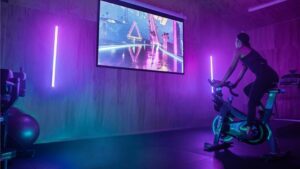
In 2024, fitness technology is transforming workouts in unprecedented ways, integrating advanced tools and innovative solutions to enhance training experiences and results. This article explores the emerging fitness technologies that are shaping workouts this year, highlighting their benefits and how they cater to various fitness needs.
1. Smart Wearables: Beyond Step Counting
Smart wearables, such as fitness trackers and smartwatches, have evolved significantly. Today’s devices offer real-time feedback on various metrics including heart rate variability, oxygen saturation, and stress levels. Advanced models now include built-in GPS, ECG monitoring, and even body temperature tracking. These features enable users to monitor their health more comprehensively and tailor their workouts based on accurate, personalized data.
2. AI-Powered Personal Training
Artificial Intelligence (AI) is making waves in personal training. AI-powered fitness apps provide customized workout plans by analyzing user data, such as exercise history, fitness goals, and even mood. These apps adapt workouts dynamically, offering real-time adjustments and progress tracking. The use of AI not only personalizes fitness plans but also helps users maintain motivation by providing instant feedback and encouragement.
3. Virtual Reality (VR) Fitness
Virtual Reality is revolutionizing the fitness industry by creating immersive workout experiences. VR fitness programs transport users to virtual environments where they can engage in activities like cycling through scenic landscapes or participating in interactive sports. This technology makes workouts more engaging and enjoyable, which can lead to increased adherence and better overall fitness outcomes.
4. Smart Equipment and Connected Machines
Smart fitness equipment is now a staple in modern gyms and home fitness setups. Machines like smart treadmills, rowing machines, and stationary bikes offer integrated screens and connectivity features. These devices sync with fitness apps to provide real-time performance metrics and personalized feedback. For instance, some treadmills adjust their incline and speed based on user performance, creating a more tailored and effective workout.
5. Wearable Biometric Sensors
Wearable biometric sensors offer advanced tracking capabilities that go beyond traditional fitness metrics. These sensors can measure variables such as muscle activation, joint angles, and body composition. By providing insights into how different exercises affect the body, users can optimize their workouts to focus on specific muscle groups and improve overall efficiency.
6. Augmented Reality (AR) Workouts
Augmented Reality is enhancing the fitness experience by overlaying digital information onto the real world. AR workouts use devices like AR glasses to project exercise instructions and visual cues into the user’s environment. This technology helps users perform exercises with better form and technique, reducing the risk of injury and improving workout effectiveness.
7. Blockchain for Fitness Data Security
As fitness technology grows, so does the need for secure data management. Blockchain technology is being adopted to ensure the privacy and security of personal fitness data. By using blockchain, fitness apps and devices can provide users with greater control over their data and ensure that their information is protected from unauthorized access.
8. Wearable Hydration Monitors
Hydration is crucial for optimal performance and recovery. New wearable hydration monitors track fluid levels and electrolyte balance in real-time, reminding users to stay hydrated based on their activity levels and environmental conditions. This technology helps athletes and fitness enthusiasts maintain peak performance and prevent dehydration-related issues.
9. Biometric Feedback Integration
Integrating biometric feedback into workouts allows for more precise adjustments to exercise routines. Technologies like heart rate variability (HRV) monitors and sleep trackers provide insights into recovery and overall well-being. By aligning workouts with biometric data, users can achieve better results while minimizing the risk of overtraining and injury.
10. Gamified Fitness Experiences
Gamification is making workouts more engaging by incorporating game-like elements into fitness routines. Fitness apps and devices now include challenges, rewards, and leaderboards that encourage users to compete and achieve their goals. This approach not only enhances motivation but also makes exercising more fun and interactive.
Conclusion
The fitness landscape in 2024 is marked by the integration of cutting-edge technologies that personalize and enhance workout experiences. From AI-powered personal training and VR fitness to smart equipment and blockchain for data security, these innovations are reshaping how we approach exercise and wellness. As technology continues to advance, it will undoubtedly bring even more transformative solutions to the world of fitness, helping users achieve their goals more effectively and enjoyably. Embracing these emerging technologies can lead to a more engaging and personalized fitness journey, paving the way for a healthier future.




